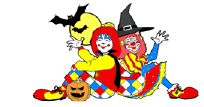
Colors matter. I've often talked with my art students about this in our classes and encouraged them to step back from paintings to get an idea of the color balance. Sometimes they are surprised by how often artists opts for complementary colors to create balance in a work. Complementary colors are the colors which are opposite each other on the color wheel: yellow/purple, orange/blue, or green/red.
In today's quick butterfly, we're using complementary colors to create the optimal color balance for the design. You don't have to limit this educated use of colors to butterfly designs, of course. This week, think about color balance as you're painting in each design and incorporate some complementary color combinations to see how they affect the overall look of your work.
Material
• Brilliant Bling metallic split cake (SillyFarm)
• Small split with teal and blues (Cameleon rainbow split)
• White face paint (Wolfe white)
• Jewel cluster
• Skin-safe adhesive
• Cosmetic-grade glitter
• #4 round brush
• 1/2-inch angle brush
• Butterfly/teardrop-shaped sponge
Tutorial
Begin by placing a small amount of skin-safe adhesive on the back of your jewel cluster so it can dry while you're working, and load your sponge from the Brilliant Bling metallic split cake with the darkest colors (reds and oranges) on the wide end and the lightest colors (golds) on the narrow tip. Create a butterfly shape on either side of the face. I added magenta glitter to the outer edges of the wings, but you can use whatever color you feels will work best with your design.
Load your angle brush from teals/blues in a small split cake of your choice and pull some of these colors in from the edges or center areas of the wings. At this point you can see how the colors "complement" each other, even though they are opposite on the color wheel.
Use the same split and brush to pull some shapes toward your central jewel cluster after placing it on the center of the forehead just above the eyebrows.
Finally, use a #4 or #5 round brush to add swirls, teardrops, and dots to the design. For small lines and dots, stay up on the tip of the brush. The more you press down, the wider your lines will be.

Beth MacKinney is the owner of and primary face painter for Face Paint Pizzazz in Elgin, Illinois, and her artwork has appeared in The Colored Palette and SkinMarkz magazines. She services Elgin, Illinois, the NW Chicago suburbs, and northern Chicago, as well as the eastern suburbs of Rockford. Stop by Facepaint.com to check out her other face painting blog posts and tutorials.



